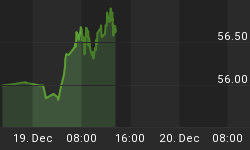This week, based on indicators of improving Chinese manufacturing activity, commodity and stock markets surged in the Pacific Rim. It appears that China's recession-fighting policies are being judged successful. The 41 percent rally in Chinese stocks in 2009 from the 2008 lows dwarfs the single digit rallies in the U.S. and Europe. With Western economies still sluggish, eyes are turning eastward for solutions to the global economic riddle. As such, recent hints at the direction of Chinese monetary policy should be closely regarded.
At the recent G-20 London meetings, China called for a new international monetary order with a gold link. This was followed by the sudden disclosure that China had used part of its huge gold output to boost its own reserves by some 600 metric tons, a 75% increase in total holdings since 2003. In his first hundred days in office, President Obama's administration has injected nearly $40 billion each day into U.S. economy. Given the inflationary impact that such a torrent of new cash will spark, it is logical that the Chinese hedge their $1 trillion dollar position with a more reliable store of value.
International money continues to flood towards the Chinese economic sphere, leaving the 'old' industrial economies of America and Europe out in the cold. The cause is quite simple: the economies of America and China are mirror images of each other. The China-centric countries are producer-dominated and America is consumer-dominated. Over time, this dichotomy is producing massive shifts in global wealth.
For a century, American Administrations have relied on the inflationary powers of paper money to finance consumer growth. The fact that the U.S. dollar is the world's reserve currency enabled this scheme to persist for longer than would have been tolerated otherwise. The Bush-Obama "stimulus and bailout" agenda is the same practice on overdrive. While driving the country further into debt, it also ensures that it will be progressively less competitive in the global economy.
China, on the other hand, is the world's largest producer and one of the top three exporters, piling up vast current account surpluses, especially in U.S. dollars. In order not to boost its currency to levels that would make its exports less competitive, China maintained its U.S. dollar surpluses in dollars, investing the bulk, almost $1 trillion, of them in U.S. Treasuries. This acted as "vendor financing" for its exports to America. The technique is similar to television commercials that promise "make no payments for 4 years", except in this case the deal is pushing 40 years.
To combat the global recession, China spent some $700 billion on a stimulus package, primarily focused on infrastructure. As such spending adds more value to the economy than government make-work programs, it now appears that China's stimulus package is having positive results.
Increased economic activity in China will benefit American companies with China-sourced sales. But the majority of the American economy remains oriented toward the American consumer, and his ever-increasing ability to take on debt. This is obviously not sustainable.
The outlook for America is for hyper-stagflation, or continued economic recession accompanied by rapidly rising prices. This calls into question the continued role of the U.S dollar as the world's reserve. Surplus nations, particularly China, are voicing their growing concern. They are exploring other, less volatile arrangements. They may be considering a return to the bulwark of monetary stability: gold.
Now the world's largest gold producer, China would benefit tremendously from a shift away from the U.S. dollar and toward gold. She is clearly interested in world leadership, but would never dream of challenging the U.S. militarily. However, in the 21st Century, the weight of economics renders martial might largely irrelevant. Still, she can't afford to act irresponsibly.
There are a few considerations that should temper her ambitions. Even with the 600 metric ton increase over the past five years, China's gold holdings amount to only 1.6 percent of its total monetary reserves. Also, at 1,050 metric tons total, China's holdings are still dwarfed by the 8,132 metric tons held by the United States.
Nevertheless, the Chinese call for a new, gold-linked reserve currency, combined with the near doubling of their own gold reserves, points to a major strategic trend that can be expected to spread to other surplus nations. The biggest winners, personal or governmental, will trade their dollars for gold before there's a rush for the door.
Private investors can ride the wave created by China's strategic shift by continuing to add to their gold positions.
For a more in-depth analysis of our financial problems and the inherent dangers they pose for the U.S. economy and U.S. dollar, read Peter Schiff's newest book "The Little Book of Bull Moves in Bear Markets." Click here to order your copy now.
For a look back at how Peter predicted our current problems read the 2007 bestseller "Crash Proof: How to Profit from the Coming Economic Collapse." Click here to order a copy today.
More importantly, don't wait for reality to set in. Protect your wealth and preserve your purchasing power before it's too late. Discover the best way to buy gold at www.goldyoucanfold.com. Download Euro Pacific's free Special Report, "Peter Schiff's Five Favorite Investment Choices for the Next Five Years", at http://www.europac.net/report/index_fivefavorites.asp. Subscribe to our free, on-line investment newsletter, "The Global Investor" at http://www.europac.net/newsletter/newsletter.asp. And now watch the latest episode of Peter's new video blog, "The Schiff Report", at http://www.europac.net/videoblog.asp.















